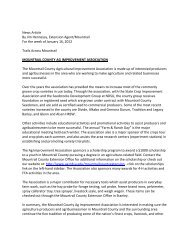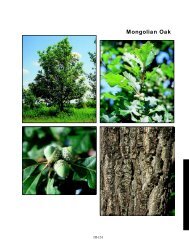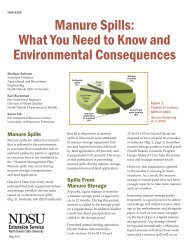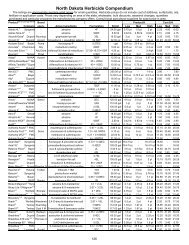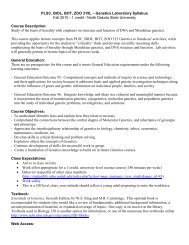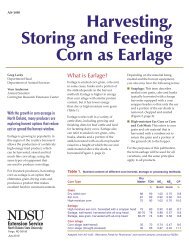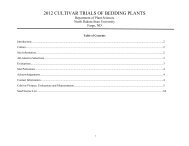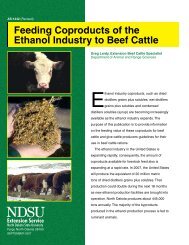NDSU Beef Feedlot - NDSU Agriculture - North Dakota State ...
NDSU Beef Feedlot - NDSU Agriculture - North Dakota State ...
NDSU Beef Feedlot - NDSU Agriculture - North Dakota State ...
Create successful ePaper yourself
Turn your PDF publications into a flip-book with our unique Google optimized e-Paper software.
Table 1. Dietary ingredient and nutrient concentration of calf growing diets.<br />
Item<br />
Ingredient, % DM basis<br />
Receiving diet Growing diet<br />
Cracked corn 31.8 31.7<br />
Deccox crumbles 1.5 1.5<br />
Dried distillers grains w/solubles 12.6 12.6<br />
Growing supplement a<br />
3.9 4.2<br />
Limestone 0.5 0.5<br />
Mixed hay b<br />
39.8 39.6<br />
Oat silage 9.3 9.3<br />
Sodium bicarbonate 0.6 0.6<br />
Nutrient Concentration c<br />
DM, % 77.1 74.9<br />
CP, % DM basis 14.8 13<br />
NE g, Mcal/lb. 0.52 0.56<br />
Ca:P 2 2.1<br />
a Calf growing supplement contained minimum 7.2% CP, 3.375% Ca, 0.27% P, 1.0%<br />
K, no animal byproducts, 350 mg/lb. Rumensin ® and MGA (melegesterol acetate) at<br />
0.5 mg (as fed).<br />
b Mixed hay composed of equal parts of ground barley and alfalfa-grass hays.<br />
c Analytical results from growing diets are from composited samples.<br />
At the onset of the background periods, weights were measured on the calves prior to morning feeding<br />
(October 14 and 15, 2008; December 4 and 5, 2008). All calves were implanted with a Ralgro implant<br />
(36 mg zeranol; Schering-Plough Animal Health Corp., Kenilworth, NJ) post weighing. During the<br />
growing period, calves were fed a 49:51 forage:concentrate diet (13% crude protein; 0.56<br />
megacalories/lb. of net energy for gain growing diet; DM basis; Table 1). All diets were formulated for<br />
2.20 pounds of daily gain. Diets were fed once daily (8 a.m.) and slick bunk management was used to<br />
determine individual pen daily feed allotments. Calves had free access to water in ice-free automatic<br />
fence-line water fountains.<br />
Calves were checked daily for signs of bloat and respiratory illness. Calf weights were recorded on day<br />
0, 1, 20, 21, 51, 52, 71, 72, 114, and 115. Initial and final weights were unshrunk body weights<br />
measured over two consecutive weigh days before morning feeding. Diet samples were collected (day<br />
6, 35, 37, 72, 78, 91, 103 and 113), composited by diet and analyzed by a commercial laboratory<br />
(Midwest Laboratories, Omaha, Neb.) for nutrient components.<br />
After backgrounding, calves (n=58) were shipped to the <strong>NDSU</strong> Carrington Research Extension Center,<br />
Carrington, ND, for finishing on January 21, 2009. During the finish period, calves were fed a diet<br />
containing 61 megacalories/pound of net energy for gain during a 105-day feeding period. Calves were<br />
fed to a common end weight (1,100 lbs.) and backfat thickness (0.4 inch) prior to harvest. During the<br />
course of finishing, 13 calves (EW = 5 and NW = 8) were harvested at a local abattoir (Barton Meats,<br />
Carrington, ND). Consequently, no carcass characteristics were measured on those calves. The<br />
remaining calves (n = 45) were harvested at Tyson Foods, <strong>Dakota</strong> City, NE, on May 5, 2009. Following<br />
Page 31 2009 <strong>NDSU</strong> <strong>Beef</strong> <strong>Feedlot</strong> Research Report



